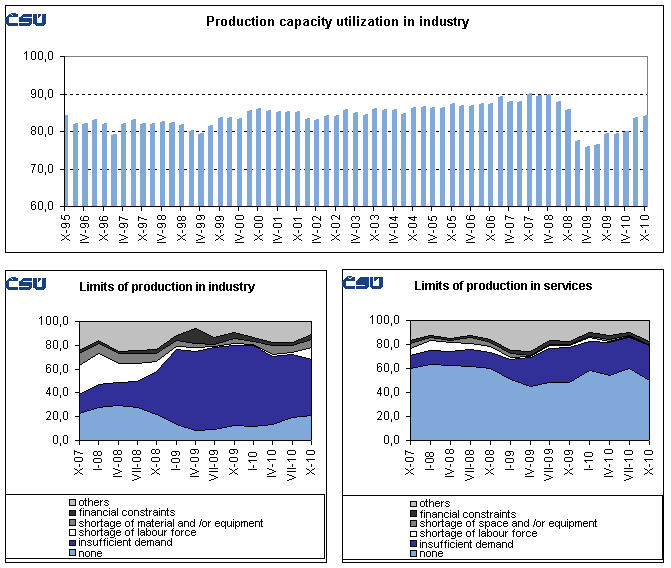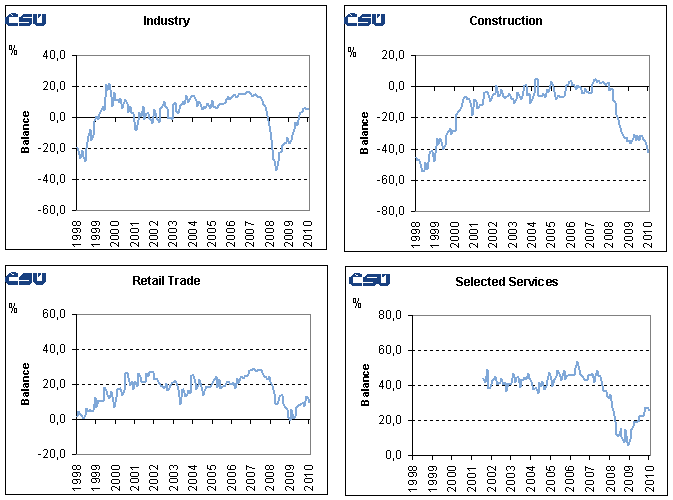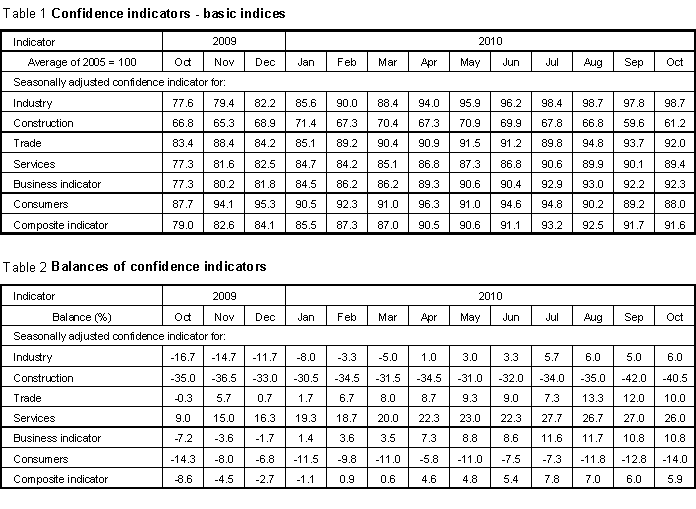Business cycle survey - October 2010
Confidence of entrepreneurs did not change, confidence of consumers decreased
Publication Date: 25. 10. 2010
Product Code: r-1201-10
Overall confidence in domestic economy decreased slightly m-o-m in October. The composite confidence indicator (economic sentiment indicator) decreased by 0.1 point, due to a decrease in consumer confidence indicator. Confidence of entrepreneurs did not change. Confidence of consumers decreased by 1.2 point, m-o-m. Compared to a low value in October 2009, the composite confidence indicator is 14.5 points up.
* * *

Business confidence indicator did not change in October compared to September. Among entrepreneurs, confidence increased slightly in industry and in construction; it slightly decreased in trade and in selected services. Compared to its first rise in the last year, the confidence of entrepreneurs is 18 points up.
In industry, the assessment of current overall economic situation in October decreased compared to September. The assessment of total demand however increased slightly. Production capacity utilization in manufacturing industry increased slightly as well in October and reached 82.5%; respondents estimate they have work secured by contracts for almost the same as in previous quarter (for 6.6 months). Most important barrier of production still is insufficient demand, even though compared to previous quarter it is stated by less respondents (47.2%), and then a shortage of labour force. According to respondents, stocks increased slightly. For next three months, respondents expect improvement of production activity by swinging employment. Expectations of general economic situation for the next three as well as six months are higher than in September. All in all, in October, the confidence in industry increased by 1 point, m-o-m; compared to low values in last year it is 22.7 points up.
In construction, the assessment of current economic situation decreased in October compared to September; low assessment of total demand hardly changed. For the period of the next three months respondents expect a slight improvement of construction activity by almost unchanged employment, compared to September. Respondents estimate that they have work secured by contracts for 8.2 months ahead. Expectations of the economic situation development for the next three months are higher than in September, for next six months they are the same. Overall, the confidence in construction increased by 1.5 points, m-o-m, and it is 5.5 points down, y-o-y.
In trade, the assessment of current economic situation in October hardly changed, compared to September. According to respondents, in October, the finished goods stocks increased. Expectations of the economic situation development for the period of the next three months are almost the same as in September, for next six months they are lower. In general, the confidence in trade decreased by 2 points, m-o-m, and it is 10.3 points up y-o-y.
In selected services, according to respondents, the assessment of current economic situation decreased compared to September. The assessment of demand hardly changed as well as its expectations for the next three months. For the period of the next three months expectations of total economic situation are the same as in September, for next six month they are higher. Overall, the confidence in selected services decreased by 1 point, compared to September; while in the y-o-y comparison it is 17 points up.
Consumer confidence indicator decreased by 1.2 point compared to September, to be 0.3 point up, compared to October 2009. The survey taken among consumers in October indicates that consumers expect for the next twelve months a decrease in the overall economic situation and namely in their own financial standing. The share of respondents expecting rises in unemployment however decreased m-o-m in October; compared to very high values in previous year it decreased markedly. Percentage of respondents planning to save money hardly changed.

Seasonally adjusted confidence indicators


Note
Contact: Marie Hörmannová, phone (+420) 274052049,
e-mail: marie.hormannova@csu.gov.cz
Data source: CZSO business survey, GfK Praha consumer survey
Business and Consumers Surveys are co-financed by grant agreements
of the European Commission DG ECFIN
End of data collection: 18 October 2010
End of data processing: 22 October 2010
Related publication: 1201-10 Business Cycle Survey in Enterprises of Industry, Construction,
Trade and Selected Services
(Publications available also at /katalog-produktu )
Methodological explanatory notes :
Since May 2010, the results are in compliance with the programme of business and consumer surveys in the EU processed according to the new CZ-NACE classification (national version of NACE Rev. 2), which replaced the former classification CZ-NACE (OKEČ, the national version of NACE Rev. 1.1). The changes apply to all data except the consumer confidence indicator. Exhaustive information on the introduction of this classification is available at: /klasifikace_ekonomickych_cinnosti_-cz_nace- . The whole time series are recalculated back, data are comparable and available at /produkty/kpr_ts .
Since January 2009, the composite confidence indicator (economic sentiment indicator) is in compliance with the EU methodology presented as a weighted average of seasonally adjusted confidence indicators in industry, construction, trade, selected services and seasonally adjusted consumer confidence indicator . Composite business confidence indicator is a weighted average of seasonally adjusted confidence indicators in industry, construction, trade and selected services.
Since January 2006, due to the inclusion of confidence indicator in selected services, a new weighting system has been used : confidence indicator in industry is assigned the weight of 40%, in construction and trade 5% each, in services 30%, and consumer confidence indicator is assigned the weight of 20%. Indicators are presented as basic indices, the base being the average of 2005. Time series of composite and business confidence indicator are recalculated, using the new weighting system – back to May 2002 (the beginning of the business cycle survey in selected services). The whole time series of base indices are then re-based to the average of 2005; the data are comparable.
Text not edited for language.
